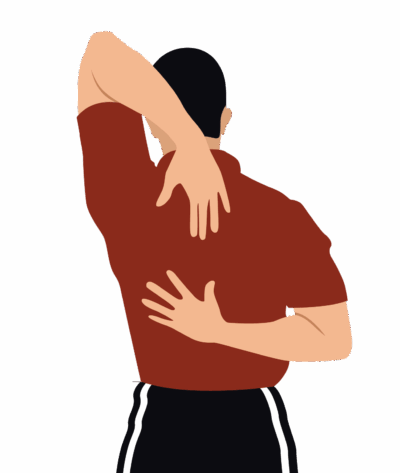Apley Scratch Test
The Apley Scratch Test is a quick, functional orthopedic assessment that evaluates overall shoulder range of motion, flexibility, and the ability of key muscles and connective tissues to lengthen and move together. It is especially used to screen for restrictions related to rotator cuff injury, adhesive capsulitis (“frozen shoulder”), shoulder impingement, or muscle tightness.
How the Test is Performed
The test has two parts performed bilaterally:
-
Superior (Overhead) Test:
-
The client reaches one arm overhead and down behind the neck, aiming to touch (or reach as close as possible to) the top of the opposite scapula.
-
Assesses abduction and external rotation of the reaching shoulder.
-
-
Inferior (Behind Back) Test:
-
The client reaches the other arm behind the back, moving upward to touch the lower part of the opposite scapula.
-
Assesses adduction and internal rotation of the shoulder.
-
-
The examiner observes the ease, range, and any pain or restriction with each motion, and notes distance between hands/fingers if not touching.
Clinical Significance
-
Normal: The client performs both movements easily, with fingers reaching or overlapping on the scapula, and no significant pain.
-
Positive Sign: Reduced range, pain, stiffness, or asymmetry is noted—cannot reach or painful at end range. Indicates possible joint, muscle, or capsular dysfunction.
-
Measurement (e.g., distance between fingers) is used to track progress and compare sides.
-
Reveals restrictions in rotator cuff, capsule, deltoid, triceps, biceps, and thoracic spine mobility.
-
Highlights functional limitations that directly impact daily and athletic activities (dressing, overhead reach, pushing, pulling).
Assessment
-
Use the test when clients report shoulder pain, stiffness, or functional limitations to screen for source of restriction.
-
Results inform targeted treatment. The therapist should identify whether limitation is due to muscle shortness, capsular tightness, rotator cuff dysfunction, or postural patterning.
-
Record baseline and progression following manual therapy or exercise.
Treatment
-
Positive test directs attention to soft tissue mobilization and stretching of restricted muscles, joint capsule techniques, and postural correction work.
-
Avoid aggressive techniques that provoke pain or end-range tissue stress; adapt treatment based on client tolerance and stage of restriction.
-
Pair hands-on therapy with corrective exercises and education to restore functional mobility.
Safety and Referral
-
If unable to perform due to significant pain or end-feel, or if test reproduces sharp pain, refer to appropriate provider for further evaluation before aggressive intervention.
-
Chronic loss of motion may indicate adhesive capsulitis, rotator cuff tear, or joint pathology needing multidisciplinary care.

